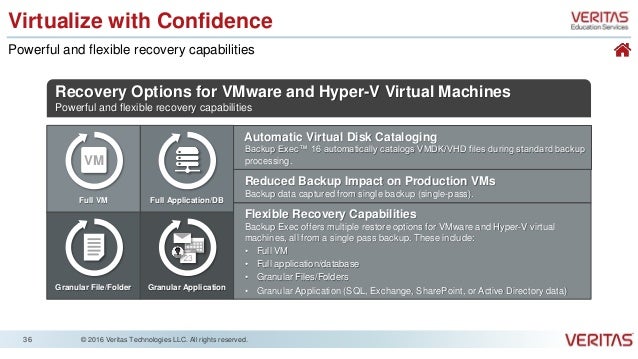

- BACKUP EXEC 16 VIRTUAL TAPE LIBRARY UNLIMITED DRIVE OPTION HOW TO
- BACKUP EXEC 16 VIRTUAL TAPE LIBRARY UNLIMITED DRIVE OPTION ARCHIVE
- BACKUP EXEC 16 VIRTUAL TAPE LIBRARY UNLIMITED DRIVE OPTION WINDOWS
BACKUP EXEC 16 VIRTUAL TAPE LIBRARY UNLIMITED DRIVE OPTION WINDOWS
On the Start menu of your Windows client computer, enter iscsicpl.exe in the Search Programs and files box, locate the iSCSI initiator program, and then run it. However if speed is NOT an issue I would virtualize the backup server, it does however PIN the VM to a given ESX host so if that goes down you have restoration issues, etc.Įdward L. To connect your Windows client to a storage volume. I rather use a VCB proxy server that is also a physical backup server. Database backup Many AWS database services (relational and non-relational) have built-in, automated backup capabilities to protect your data and applications. However it is really the read speed of the VMDKs from ESX that is slow. Use AWS Storage Gateway to create virtual tape libraries and eliminate the responsibilities of overseeing procurement cycles and error-prone processes. Or is bypassing this throttling actually not such a great idea because it can choke I/O for all your VMs on that ESX host? For me the major motivator to go to LTO4 was capacity rather than speed in any case but I'm wary of setting it up in a stupid way early on, then only realising later on when I can't go back on the decision. The Virtual Tape Library (VTL) Unlimited Drive Option provides simple. This is the SAS write speed through a VM. Backup Exec has an expansive portfolio of high-powered agents and options to. Writing to tape will always be slower in a VM. If you could use NPIV for non-disk LUNs then it would be great to use but that is not the case. Hi Texiwill, does your point 2 mean that it really isn't a good idea to have a virtualized backup server? Hardly the 7200MB/min the drive is capable of. I suspected Backup Exec overheads/network performance with remote machines but it seems I can rarely achieve over 1500MB/min even for large local files (VMDKs) on SAS disk (separate controller). I'm not seeing any improvement at all over LTO2 which I just migrated from, and even on real hardware rather than virtual. I'm disappointed in LTO4 on SAS performance generally though.
BACKUP EXEC 16 VIRTUAL TAPE LIBRARY UNLIMITED DRIVE OPTION ARCHIVE
Tape Gateway integrates with all leading backup applications allowing you to start using cloud storage for on-premises backup and archive without any changes to your backup and archive workflows.
BACKUP EXEC 16 VIRTUAL TAPE LIBRARY UNLIMITED DRIVE OPTION HOW TO
It's not obvious how to add it - you can't select new SCSI controller, you have to add the devices but scroll down the list when it offers you the choice of SCSI IDs to 1:1 instead of 0:1 for instance. Tape Gateway stores your virtual tapes in S3 buckets managed by the AWS Storage Gateway service, so you don’t have to manage your own Amazon S3 storage. I used a second controller (paravirtualized SCSI) for these devices. I built the system using LSI SAS for the primary controller (thinking I would use the autoloader on this card) then I realized that I should probably keep disk I/O and tape I/O segregated. I've been using my virtualized backup server for a bit now and it is nearly real world performance - I'd say around 80% which for a lot of people will justify freeing up another server.


 0 kommentar(er)
0 kommentar(er)
